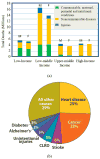On a chip
- PMID: 22147065
- PMCID: PMC4493052
- DOI: 10.1109/MPUL.2011.942762
On a chip
Abstract
The future of clinical and POC BioMEMS is very bright. With an increasing emphasis on the personalization of medicine and the rising costs of health care, early detection and diagnostics at the POC will be even more important. Early detection implies early intervention, resulting in the saving of lives and reducing overall spending. The potential impact of these technologies on the early diagnosis and management of both communicable and noncommunicable diseases is very high. Many grand challenges applications are possible, e.g., routine tests such as complete blood cell count on a chip that an individual can perform at home; detection of cardiac markers from blood after a perceived heart attack; detection of cancer markers such as exosomes, CTCs from blood, or protein biomarkers in serum; and detection of infectious agents such as virus and bacteria for public health. These applications are expected to result in new diagnostic assays for home, doctor's office, clinical laboratories, and various POC settings.
Figures








References
-
- WHO. The Global Status Report on Non-communicable Diseases. 2010 http://www.un.org/ga/search/view_doc.asp?symbol=A/66/83&Lang=E.
-
- Cancer Facts and Figures 2010. American Cancer Society; http://www.cancer.org/acs/groups/content/@nho/documents/document/acspc-0....
-
- CDC/NCHS. Health, United States, 2010, Figure 24. http://www.cdc.gov/nchs/data/hus/hus10_InBrief.pdf.
-
- Bashir R. BioMEMS: State of the Art in Detection and Future Prospects. Advanced Drug Delivery Review. 2004;56(11):1565–1586. - PubMed
MeSH terms
Grants and funding
LinkOut - more resources
Full Text Sources
Medical

